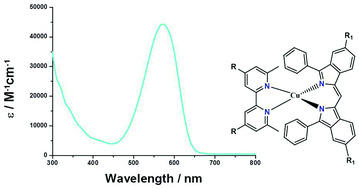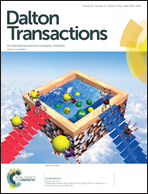Neutral copper(i) dipyrrin complexes and their use as sensitizers in dye-sensitized solar cells†
Abstract
Heteroleptic neutral copper(I) dipyrrin complexes have been synthesised with the general formula [Cu(4,4′-(R)-6,6′-(CH3)-bipyridine)(dipyrrin)], R = CH3 or CO2Et, and H-dipyrrin is either 1,3,7,9-tetramethyldipyrromethene (HL1), 1,13-diphenyl-6,8-diisoindolemethene (HL2), or 1,13-diphenyl-3,11-di(trifluoromethyl)-6,8-diisoindolemethene (HL3). Improved stability was observed across the series L1–L3, likely due to better steric constraints between the ligands. Visible light absorption has also been enhanced with a red-shift in absorption from 450 nm to 600 nm. Complex 3 shows photoluminescence lifetime in the order of nanoseconds suggesting singlet fluorescence which is supported by theoretical calculations. Study of the complexes as sensitisers in dye-sensitised solar cells was achieved by assembling the dye in situ on the surface of TiO2 in a series of steps (anchoring ligand followed by ancillary ligand and [Cu(CH3CN)4][BF4]. The highest efficiency achieved was 0.41% for the dye with HL3, attributed to better dye regeneration due to a more favourable oxidation potential.


 Please wait while we load your content...
Please wait while we load your content...